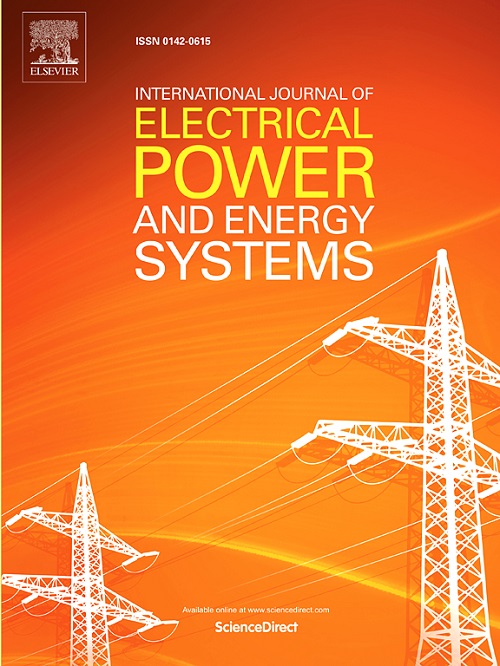Fault section location of collector lines based on phase comparison of zero-sequence current using the Kaiser window
IF 5
2区 工程技术
Q1 ENGINEERING, ELECTRICAL & ELECTRONIC
International Journal of Electrical Power & Energy Systems
Pub Date : 2025-09-25
DOI:10.1016/j.ijepes.2025.111043
引用次数: 0
Abstract
To address the limitations of existing single-phase grounding fault location methods for collector lines in wind farms, especially their insufficient adaptability to multi-branch topologies, this paper proposes a fault section location method based on phasor comparison using Kaiser windowed Fast Fourier Transform (FFT). Collector lines in large-scale wind farms generally exhibit a multi-branch topological layout similar to traditional radial distribution networks, and existing methods are limited in terms of positioning accuracy and reliability under such complex structures. Analysis shows that when a single-phase grounding fault occurs in a section or branch of the collector line, there are significant phasor differences between the faulty section and healthy sections, as well as between the faulty branch and healthy branches. Utilizing this feature, this paper adopts the Kaiser windowed FFT algorithm, which effectively suppresses spectral leakage, to calculate the mean value of phasor difference sequences between measurement points, establishes fault discrimination criteria, and achieves accurate location of faulty sections and branches. Simulation verification demonstrates that the proposed method has good adaptability to multi-branch collector lines and can significantly improve the accuracy of fault location.
基于Kaiser窗口零序电流相位比较的集电极线路故障区段定位
针对现有风电场集电极线路单相接地故障定位方法的局限性,特别是对多支路拓扑适应性不足的问题,提出了一种基于相量比较的基于Kaiser加窗快速傅立叶变换(FFT)的故障区段定位方法。大型风电场集热器线路与传统的径向配电网一般呈现多支路拓扑布局,在这种复杂结构下,现有方法的定位精度和可靠性受到限制。分析表明,当集电极线路某一段或支路发生单相接地故障时,故障支路与健康支路、故障支路与健康支路之间存在显著相量差异。利用这一特征,本文采用有效抑制频谱泄漏的Kaiser加窗FFT算法,计算测点间相差序列均值,建立故障判别准则,实现故障路段和支路的准确定位。仿真验证表明,该方法对多支路集电极线路具有良好的适应性,能显著提高故障定位的精度。
本文章由计算机程序翻译,如有差异,请以英文原文为准。
求助全文
约1分钟内获得全文
求助全文
来源期刊
CiteScore
12.10
自引率
17.30%
发文量
1022
审稿时长
51 days
期刊介绍:
The journal covers theoretical developments in electrical power and energy systems and their applications. The coverage embraces: generation and network planning; reliability; long and short term operation; expert systems; neural networks; object oriented systems; system control centres; database and information systems; stock and parameter estimation; system security and adequacy; network theory, modelling and computation; small and large system dynamics; dynamic model identification; on-line control including load and switching control; protection; distribution systems; energy economics; impact of non-conventional systems; and man-machine interfaces.
As well as original research papers, the journal publishes short contributions, book reviews and conference reports. All papers are peer-reviewed by at least two referees.

 求助内容:
求助内容: 应助结果提醒方式:
应助结果提醒方式:


